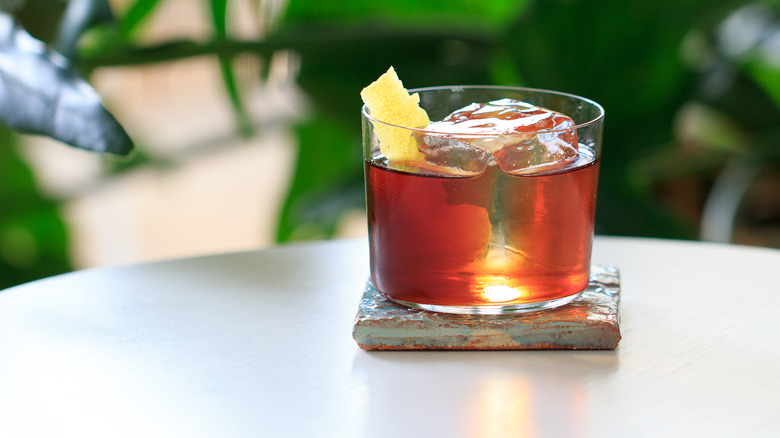The Delicate Amaro That Celebrates An Italian Princess
Unless you're a bartender, the word "amaro" might not feel as familiar as, say, "tequila." But, believe it or not, amari (the plural of amaro) are pretty much everywhere you look in the cocktail world, even for casual sippers. Industry professionals rip shots of Fernet-Branca. That Campari in your Negroni is an amaro. If you order an Aperol Spritz with brunch, then you're drinking an amaro. Perhaps you've even visited Amor Y Amargo, the cocktail bar in Manhattan's East Village dedicated to the bittersweet liqueur. (It was opened by Ravi DeRossi, one of the minds behind the world-renowned Death & Co., via Thrillist, which is also based in NYC.)
Amaro is a bitter Italian digestif, typically made from a unique blend of botanicals infused into grape brandy or wine, which is then sweetened and aged, according to Food & Wine. Bitter cocktail fans, rise up: The word "amaro" itself is Italian for "bitter." But amaro is far from a one-trick pony. Different amari range on a bittersweet spectrum from "more bitter" to "more sweet" with varying degrees of intensity. Offerings vary from the hibiscus-forward Select Aperitivo to Cynar, made from artichokes. Not to be confused with bitters, amari can (and, fans might argue, should) be used in greater quantity in cocktails; they can even serve as the base of a drink. Today, we're talking about one particular varietal: The delicate amaro that celebrates an Italian princess.
A sweet homage with a bitter liqueur
Per Liquor.com, amari varies highly based on region as different manufacturers incorporate local ingredients into their recipes. Sicilian amari, for instance, often features bitter orange. As "The Big Book of Amaro" author Matteo Zed puts it, "Amaro is the business card of a territory." In Italy today, amari are popularly enjoyed as-is over ice as aperitivi or after-dinner digestivi. But one Italian amaro manufacturer, Stanislao Cobianchi, took this sentiment of hometown pride to a new level.
Introducing Amaro Montenegro. According to the Amaro Montenegro website, its recipe features a blend of 40 botanicals, including clove, nutmeg, cinnamon, orange, coriander, marjoram, oregano, and more. The herbs and spices are then finely chopped, boiled together, macerated, and distilled. Fans have been enjoying it since 1885 — but back then, it was known by a different name. The amaro was originally called "Elisir Lungavita," and it kept the name until 1896 when Princess Elena of Montenegro married Prince Vittorio Emanuele III of Italy. To celebrate the princess, Cobianchi changed the name of his amaro to her namesake, and the rest is (literally) history. Food & Wine calls Amaro Montenegro "one of the lightest and gentlest amari," with top notes of orange and rosewater, making the formula a decidedly fitting homage to an Italian princess.

